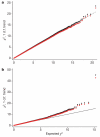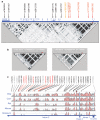Genome-wide association study identifies novel breast cancer susceptibility loci
- PMID: 17529967
- PMCID: PMC2714974
- DOI: 10.1038/nature05887
Genome-wide association study identifies novel breast cancer susceptibility loci
Abstract
Breast cancer exhibits familial aggregation, consistent with variation in genetic susceptibility to the disease. Known susceptibility genes account for less than 25% of the familial risk of breast cancer, and the residual genetic variance is likely to be due to variants conferring more moderate risks. To identify further susceptibility alleles, we conducted a two-stage genome-wide association study in 4,398 breast cancer cases and 4,316 controls, followed by a third stage in which 30 single nucleotide polymorphisms (SNPs) were tested for confirmation in 21,860 cases and 22,578 controls from 22 studies. We used 227,876 SNPs that were estimated to correlate with 77% of known common SNPs in Europeans at r2 > 0.5. SNPs in five novel independent loci exhibited strong and consistent evidence of association with breast cancer (P < 10(-7)). Four of these contain plausible causative genes (FGFR2, TNRC9, MAP3K1 and LSP1). At the second stage, 1,792 SNPs were significant at the P < 0.05 level compared with an estimated 1,343 that would be expected by chance, indicating that many additional common susceptibility alleles may be identifiable by this approach.
Figures



Similar articles
-
Heterogeneity of breast cancer associations with five susceptibility loci by clinical and pathological characteristics.PLoS Genet. 2008 Apr 25;4(4):e1000054. doi: 10.1371/journal.pgen.1000054. PLoS Genet. 2008. PMID: 18437204 Free PMC article.
-
Clinical correlates of low-risk variants in FGFR2, TNRC9, MAP3K1, LSP1 and 8q24 in a Dutch cohort of incident breast cancer cases.Breast Cancer Res. 2007;9(6):R78. doi: 10.1186/bcr1793. Breast Cancer Res. 2007. PMID: 17997823 Free PMC article.
-
Distribution of FGFR2, TNRC9, MAP3K1, LSP1, and 8q24 alleles in genetically enriched breast cancer patients versus elderly tumor-free women.Cancer Genet Cytogenet. 2010 May;199(1):69-72. doi: 10.1016/j.cancergencyto.2010.01.020. Cancer Genet Cytogenet. 2010. PMID: 20417875 No abstract available.
-
Breast cancer genome-wide association studies: there is strength in numbers.Oncogene. 2012 Apr 26;31(17):2121-8. doi: 10.1038/onc.2011.408. Epub 2011 Sep 26. Oncogene. 2012. PMID: 21996731 Review.
-
Genetic susceptibility loci for breast cancer by estrogen receptor status.Clin Cancer Res. 2008 Dec 15;14(24):8000-9. doi: 10.1158/1078-0432.CCR-08-0975. Clin Cancer Res. 2008. PMID: 19088016 Free PMC article. Review.
Cited by
-
Identification of a breast cancer susceptibility locus at 4q31.22 using a genome-wide association study paradigm.PLoS One. 2013 May 22;8(5):e62550. doi: 10.1371/journal.pone.0062550. Print 2013. PLoS One. 2013. PMID: 23717390 Free PMC article.
-
Genetic variants at 6p21.1 and 7p15.3 are associated with risk of multiple cancers in Han Chinese.Am J Hum Genet. 2012 Nov 2;91(5):928-34. doi: 10.1016/j.ajhg.2012.09.009. Epub 2012 Oct 25. Am J Hum Genet. 2012. PMID: 23103227 Free PMC article.
-
Breast cancer susceptibility associated with rs1219648 (fibroblast growth factor receptor 2) and postmenopausal hormone therapy use in a population-based United States study.Menopause. 2013 Mar;20(3):354-8. doi: 10.1097/GME.0b013e318268ca46. Menopause. 2013. PMID: 23435034 Free PMC article.
-
Prediction of breast cancer risk by genetic risk factors, overall and by hormone receptor status.J Med Genet. 2012 Sep;49(9):601-8. doi: 10.1136/jmedgenet-2011-100716. J Med Genet. 2012. PMID: 22972951 Free PMC article.
-
A two-stage association study identifies methyl-CpG-binding domain protein 2 gene polymorphisms as candidates for breast cancer susceptibility.Eur J Hum Genet. 2012 Jun;20(6):682-9. doi: 10.1038/ejhg.2011.273. Epub 2012 Jan 18. Eur J Hum Genet. 2012. PMID: 22258532 Free PMC article.
References
-
- Collaborative Group on Hormonal Factors in Breast Cancer Familial breast cancer: Collaborative reanalysis of individual data from 52 epidemiological studies including 58 209 women with breast cancer and 101 986 women without the disease. Lancet. 2001;358:1389–1399. - PubMed
-
- Miki Y, et al. A strong candidate for the breast and ovarian-cancer susceptibility gene BRCA1. Science. 1994;266:66–71. - PubMed
-
- Wooster R, et al. Identification of the breast cancer susceptibility gene BRCA2. Nature. 1995;378:789–792. - PubMed
Publication types
MeSH terms
Substances
Grants and funding
LinkOut - more resources
Full Text Sources
Other Literature Sources
Medical
Research Materials
Miscellaneous

